
The statue of Willoughby Dayton Miller and bust of John R. Callahan are placed in a Postle Hall courtyard on medical campus. Credit: Summer Cartwright | Campus Editor
In the face of an evolving campus, preserving history has proven, at times, a difficult task for Ohio State.
Several landmarks, such as the statue of renowned dentist and Ohio native Willoughby Dayton Miller, are unnoticed by students.
Assembled in 1916, the tribute to Miller is the campus’ oldest statue and stood outside Thompson Library until 1978, when it was moved to its current location behind Postle Hall, uprooted from the hub of campus — The Oval — south to Medical Campus.
At a nearby Postle Hall entrance also rests a 1920 bust of John R. Callahan, another native Ohioan and pioneer in the field of dentistry. Today, these monuments stand secluded among a series of trees in the shadow of the Wexner Medical Center, both effectively invisible to those not passing by this specific building’s back entrance.
Other historical markers remain in their original locations around campus, but are either unseen by students or are unappreciated for their significance.

The bust of John R. Callahan sits next to an entrance of Postle Hall, visible to those leaving and entering the building. Credit: Summer Cartwright | Campus Editor
At the back of Ramseyer Hall, a series of inscriptions rest above three doorways, originating back to the building’s founding as University High School in 1932.
One inscription, proposed by then-professor Howard F. Seely, is taken from the Robert Browning poem, “Rabbi Ben Ezra” and reads, “Prize the Doubt, Low Kinds Exist Without.”
The purpose of these inscriptions, according to Seely, was to inspire thoughtfulness in students.
“Humans are the only creatures who are capable of doubting, and therefore it should be looked upon as an asset, rather than a liability,” an inscription reads. “A lackadaisical acceptance of everything brought to attention would soon lead to degeneracy.”
The “Doubt” inscription has begun to slowly wear away while a former entrance beneath it has been completely sealed off.
Another inscription is concealed behind a neighboring garage, blocking its message from plain sight.
While some landmarks like these are hard to notice, an even older piece of history is kept entirely from view.
Prior to 1970, the building now known as Sullivant Hall was home to the Ohio Historical Society — known now as the Ohio History Connection — and World War I memorial was featured inside the building.
This memorial included four sculpted bronze panels, each depicting the experiences of Ohio veterans. The panels were created by Bruce Wilder Saville, an ambulance driver during the war, while the memorial was designed by Joseph Bradford, an architect for many of Ohio State’s buildings.
Following the Historical Society’s relocation to its current home at 800 East 17th Avenue, the memorial was dismantled.
The panels were property of the university, so they remained at Ohio State, said Emmy Beach, public relations manager for Ohio History Connection
Only “The Victorious Doughboy,” a statue of an Ohio WWI veteran, followed the society to its new home. The panels were locked away in storage after 86 years on display, where they have remained since 2012.
Although these examples highlight the struggle of preserving campus history, the university has succeeded at several endeavors.
Tamar Chute, a university archivist, pointed to Ohio State’s ongoing effort to preserve the historical structure of campus buildings, particularly their exterior, while also updating various facets when necessary.

Mirror Lake is under construction that will alter its former appearance to that of a more historic marsh. Credit: Kevin Stankiewicz | Editor-in-chief
For example, Pomerene Hall is undergoing a $59.9 million renovation, changing the building from what was once a university gymnasium to a hub for data analytics,
Ensuring the registry of locations, such as Hale Hall, within the National Registry of Historic Places also has been a priority, Chute said. Among the most easily visible has been the university’s work to alter Mirror Lake to its historical form.
There are no shortage of memorials on campus today. Yet while some, like the statue of William Oxley Thompson, stand clearly visible to passersby, others remain tucked away from plain sight. With so much history for Ohio State to maintain and new structures being built regularly, preservation is likely to remain a constant balancing act.


